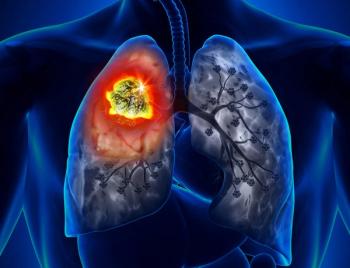
IMMU-132 Encouraging in Previously Treated Metastatic Lung Cancer
The investigational agent IMMU-32 is well-tolerated in patients with previously-treated metastatic lung cancer, and interim survival data are “encouraging.”
Repeated cycles of monotherapy with the investigational antibody-drug conjugate (ADC) IMMU-32 are well-tolerated and interim survival data are “encouraging” among patients with progressive or refractory, previously treated metastatic small-cell and non–small-cell lung cancers (SCLC and NSCLC), according to authors of a phase I/II study presented at the 2015 World Conference on Lung Cancer in Denver, Colorado (abstract
“IMMU-132 is a novel ADC with acceptable safety profile (neutropenia, alopecia, and diarrhea) in heavily-pretreated NSCLC and SCLC patients,” reported lead study author D. Ross Camidge, MD, of the University of Colorado Cancer Center, in Aurora, Colorado. “Repeated doses can be given over months without evoking interfering host antibodies.”
IMMU-132 (sacituzumab govitecan) is an investigational antibody drug conjugate composed of a therapeutic payload SN-38, the active metabolite of the topoisomerase I inhibitor irinotecan, conjugated to an anti-Trop-2 humanized antibody, with a high drug-to-antibody ratio of 7.6.
“Trop-2 an epithelial (cancer) marker that is expressed in many cancer types, including both small-cell and non–small-cell lung cancers,” Dr. Camidge explained.
Preclinical xenograft study data suggests IMMU-132 may deliver up to 136 times as much SN-38 than irinotecan.
The study enrolled a total of 57 patients with refractory or progressive metastatic disease following a median of 3 prior therapies (NSCLC patients; range: 1–8) and 2.5 prior therapies (SCLC; range: 1–7). The phase II trial was an extension of the phase I study.
Patients were administered IMMU-132 at doses ranging from 8 to 18 mg/kg during a phase I run-in phase, on days 1 and 8 every 21 days until disease progression or unacceptable toxicity.
“The maximum tolerated (MTD) dose was 12 mg/kg, but 8 and 10 mg/kg were the doses explored in the phase II expansion portion of the study,” Dr. Camidge said. “Ultimately, 10 mg/kg has been determined to be the dose to take forward.”
Across all doses, 28 participants with NSCLC and 29 participants with SCLC were treated.
The objective response rate was 32% for patients with NSCLC and 30% for patients with SCLC, Dr. Camidge reported.
Of 19 assessable patients with NSCLC treated at the MTD or lower, at the interim analysis, 6 experienced RECIST 1.1 partial responses (PRs) and 8 experienced stable disease (SD); 5 patients with NSCLC experienced progressive disease. Of 20 assessable patients with SCLC, 6 experienced PRs, 5 had SD, and 9 experienced progressive disease. No complete responses (CRs) were reported. The disease control rate (CR + PR + SD) was therefore 74% for patients with NSCLC and 55% for patients with SCLC, Dr. Camidge noted.
Median progression-free survival (PFS) for patients with NSCLC was 3.4 months for the 8 mg/kg group (n = 8; PFS maturity, 62%) and 5.4 months at 10 mg/kg (n = 16; PFS maturity, 56%). For patients with SCLC, median PFS was 2 months for the 8 mg/kg group (n = 15; PFS maturity, 87%) and 4.6 months in the 10 mg/kg group (n = 6; PFS maturity, 83%).
“There was no evidence of an antibody response to IMMU-132, even after repeated administration,” emphasized Dr. Camidge.
“Side effects in our study were actually worse at 8 mg than at 10 mg,” he said.
Adverse events affecting ≥ 10% of patients at the 8 and 10 mg/kg doses included diarrhea (43% of patients in the 8 mg/kg dose group vs 26% of patients in the 10 mg/kg group), nausea (52% vs 26%), fatigue (57% vs 6%), alopecia (39% vs 16%), and neutropenia (30% vs 13%).
“Severe side effects were dominated by diarrhea and neutropenia-although, again, 10 mg/kg was better tolerated,” Dr. Camidge said. “And at this dose, only 10% of patients had a grade 3 or 4 neutropenic event, and zero had a grade 3 or higher diarrhea event-consistent with the targeted nature of IMMU-132.”
Grade 3/4 adverse events affecting more than 2% of patients in the 8 and 10 mg/kg treatment groups included neutropenia (22% vs 10%), diarrhea (9% vs 0%), leukopenia (4% vs 6%), anemia (9% vs 3%), atrial fibrillation (9% vs 0%), hyperglycemia (4%; 3%), hyponatremia (9% vs 0%), lymphopenia (4% vs 3%), and febrile neutropenia (0% vs 3%).
Dose reductions occurred in 17% of patients in the 8 mg/kg group and 13% of patients in the 10 mg/kg group, Dr. Camidge reported.
The study was funded by Immunomedics, Inc.
Newsletter
Stay up to date on recent advances in the multidisciplinary approach to cancer.


















































































